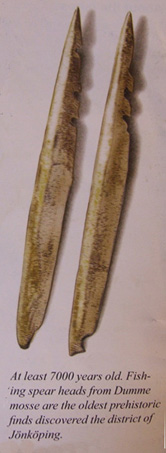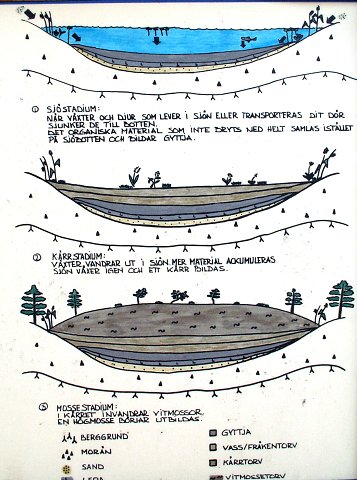

 How Dumme mosse was forme
How Dumme mosse was forme
As the inland ice retreated around 10,000 years ago, the Vätter Ice Lake was formed. In this lake a large amount of sand was left, forming an undulating sandy floor. The largest part of Dumme Mosse is a result from the growth of Sphagnum mosses as the area became swampy and wet. The peat layers are between 2 and x metres thick and lie on top of the sand floor. The islets of firm land consist of either solid rock or banks of sand, as the name „Sandreveln“ (sand bank) suggests.
Cultural history
Cultural activity has a long history at Dumme mosse. For example, the oldest evidence of human existence in the area around Jonkoping has been discovered in the bog. The find was a pair of rough-toothed fishing spear heads made of bone, dating back to 7000-5000 BC. In the outskirts of Dumme mosse there is a small road, at times no more than a path. It is called Nissastigen – the medieval road between Jonkoping and Halmstad. In the past, there was frequent traffic between the two towns. Close to the old railway embankment at Jäboan is Britas källa (Brita´s spring) which was known to give lifelong health if someone tossed coins into it. In the area there are remnants of charcoal stacks and iron production sites.
Dumme mosse – tranquility all year round
Dumme mosse is one of the largest wetlands in the county. The nature reserve covers around 30 km2 and is fairly unspoilt. As a result, there is a rich flora and fauna. During the warm season, in quiet moments, you may hear the plaintive cries of the Golden Plover. During the winter, skiing is a great way to explore the bog. The walking path at Dumme mosse was built as early as 1968. About 2 km is adapted for wheelchairs and prams, to the benefit of many visitors.


About the mires
The mires may very well be called the last wilderness of southern Sweden. There is a scent of Labrador Tea, and a rich diversity of flora and fauna. Mire is a general name for bogs and fens. The bogs of Smaland consist mainly of Sphagnum mosses, but also of roots and fibres from Cottongrass and Deergrass. Overall, the amount of wetlands in Sweden has diminished. Leaching nitrogen threatens the natural vegetation. Drainig and peat excavation have become increasing threats. These threats are to be taken seriously as mires and wetlands are extremely valuable from an ecological perspective. They can reduce the effect of large floods and also act as natural water purification systems.
If you want to log this cache, you have to complete three tasks:
1) Take a picture of you by the Dumme mosse near coordinates with small lake in background at the place. You have to hold GPS in your hand and upload the image to your log. Now optional
2) Send me an answer (via email), on the near information boards find the names of two plants which grow in the surrounding. (or names of two birds)
3) And send me an answer (via email), how many metres are thick the peat layers? (Information is on the info board near "WP board" (57° 44.890 14° 04.130)).
E-mail write in English or German, please.